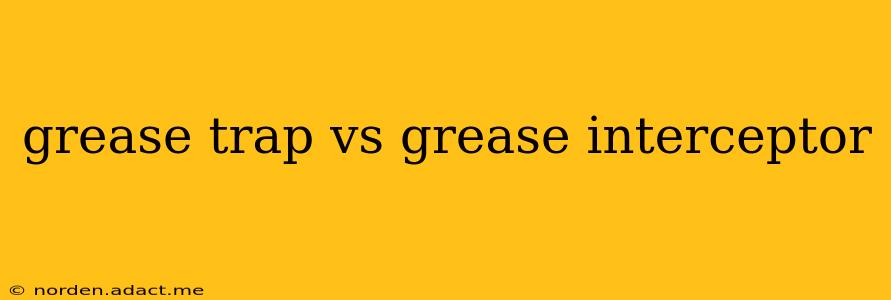Choosing between a grease trap and a grease interceptor can seem daunting, especially if you're unfamiliar with the specifics of each. Both systems are designed to prevent fats, oils, and greases (FOGs) from entering sewer lines and causing costly clogs and environmental damage. However, there are crucial differences in their design, capacity, and regulatory compliance. This comprehensive guide will clarify the key distinctions, helping you make an informed decision for your specific needs.
What is a Grease Trap?
A grease trap is a relatively simple device, typically a small, underground tank that uses gravity to separate FOGs from wastewater. Wastewater flows into the trap, allowing heavier FOGs to settle at the bottom while lighter wastewater overflows and continues to the sewer system. Periodically, the accumulated FOGs must be manually pumped out and disposed of properly. Grease traps are often found in smaller establishments with low FOG generation, such as small restaurants or cafes.
Advantages of Grease Traps:
- Lower Initial Cost: Grease traps generally have a lower upfront cost compared to grease interceptors.
- Simple Design & Maintenance (relatively): Their simple design means they are relatively easy to understand and maintain, although regular pumping is still essential.
Disadvantages of Grease Traps:
- Limited Capacity: They are less efficient at handling larger volumes of wastewater containing FOGs.
- Higher Maintenance Frequency: Frequent pumping is necessary to prevent overflows and backups.
- Less Effective at FOG Removal: They are less effective than interceptors at removing FOGs, leading to a higher risk of sewer blockages.
- May Not Meet Regulations: In many areas, grease traps may not meet stringent regulatory requirements for FOG management.
What is a Grease Interceptor?
A grease interceptor is a more sophisticated system designed to efficiently separate FOGs from wastewater in high-volume applications. They utilize various mechanisms, including gravity separation, baffles, and sometimes even mechanical components, to capture a greater percentage of FOGs. Grease interceptors are commonly found in larger commercial kitchens, food processing facilities, and other establishments producing significant FOG waste.
Advantages of Grease Interceptors:
- Higher Capacity: They can handle larger volumes of wastewater and higher concentrations of FOGs.
- More Effective FOG Removal: Their advanced design leads to significantly improved FOG removal efficiency, reducing the risk of sewer blockages.
- Longer Maintenance Intervals: Due to their larger capacity, less frequent pumping is typically required.
- Compliance with Regulations: Grease interceptors are often necessary to meet local and national environmental regulations.
Disadvantages of Grease Interceptors:
- Higher Initial Cost: Grease interceptors have a significantly higher initial cost compared to grease traps.
- More Complex Maintenance: Regular inspection and maintenance, including potential cleaning of baffles and other components, is necessary.
What are the Key Differences Between a Grease Trap and a Grease Interceptor?
| Feature | Grease Trap | Grease Interceptor |
|---|---|---|
| Size & Capacity | Smaller, lower capacity | Larger, higher capacity |
| Design | Simple gravity-based separation | More complex design, may include baffles & mechanical components |
| Efficiency | Lower FOG removal efficiency | Higher FOG removal efficiency |
| Maintenance | More frequent pumping required | Less frequent pumping, more complex maintenance |
| Cost | Lower initial cost | Higher initial cost |
| Regulatory Compliance | May not meet stringent regulations | Typically required for regulatory compliance |
How do I Choose Between a Grease Trap and a Grease Interceptor?
The best choice depends largely on the volume of wastewater and the amount of FOG produced. Consider these factors:
- Volume of Wastewater: Larger establishments with significant wastewater flow require grease interceptors.
- FOG Production: The amount of FOG generated will determine the necessary capacity of the system.
- Local Regulations: Check with your local environmental agency to determine the required type of FOG management system.
- Budget: While grease interceptors have higher upfront costs, their long-term maintenance may be more economical.
What size grease trap or interceptor do I need?
Determining the right size is crucial. This depends on factors like daily wastewater volume, number of fixtures (sinks, dishwashers), and the type of food service. Consulting a professional plumber or waste management specialist is highly recommended to accurately assess your needs and ensure compliance with regulations. Incorrect sizing can lead to insufficient FOG removal or unnecessary overcapacity.
How often do grease traps and interceptors need to be cleaned?
Cleaning frequency varies greatly based on the system size, wastewater volume, and FOG production. Grease traps often require more frequent cleaning (sometimes monthly), while interceptors can go longer (potentially quarterly or even semi-annually). Professional pumping services should be used to ensure proper disposal of the collected FOGs.
By carefully considering these factors and seeking professional guidance, you can choose the appropriate FOG management system to protect your plumbing, comply with regulations, and maintain environmental responsibility.
